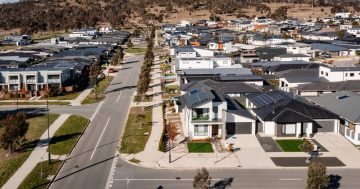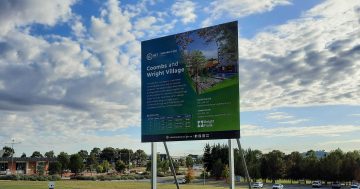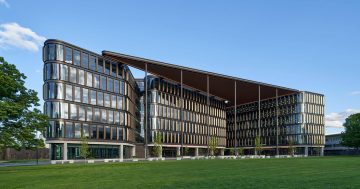
The new president of the Australian Institute of Architects’ ACT chapter Shannon Battison wants more housing diversity is the ACT. Photo: Supplied.
A cookie-cutter approach to planning and overdevelopment is condemning Canberra’s new suburbs to boring uniformity and making them incapable of coping with the ACT’s changing climate without energy-sucking air conditioning, according to the new architects head.
The president of the Australian Institute of Architects’ ACT chapter, Shannon Battison from The Mill: Architecture and Design, is on a mission to restore good design to urban planning and is worried about what the ACT’s newer suburbs will eventually look like.
She says much of the design work is basic and many blocks are being built out to the edges without thought to space around the home, where a garden and trees can provide not just a pleasant amenity but help cool a house in Canberra’s increasingly hot summers.
And while there may be a minimum 6-star energy efficiency rating on new homes, Ms Battison says there is no one checking that the built product is meeting that easily achievable standard.
“We’re allowing development to happen in our new suburbs but we’re not really in a position to think properly about what those suburbs are going to be like 15 to 20 years down the line,” she told Region Media.
“Living in a new suburb myself, I see a lot of things happening around me that we should’ve done so much better.
“A new suburb should be a testament to the best the city has to offer, all the best that our industry and profession has to offer, and I don’t think that’s the case a lot of the time.”
Calling the new suburbs a missed opportunity, Ms Battison says some of Canberra’s most-desirable suburbs such as Curtin, Weston Creek and the inner north have a high degree of input from architects who collaborated with builders.
She says this does not necessarily mean every home needs to be individually architect-designed, pointing to the architect-produced affordable housing plans released during the 1950s and 60s which could be bought cheaply off the shelf and through magazines.
“There will always be a need for architects to do those beautiful bespoke custom designs for people, but there’s also space for us to be in that mass-produced housing market, and we have to be there if we’re going to affect the quality of our housing stock,” she said.
Ms Battison contrasted the diversity of her suburb, Coombs in the Molonglo Valley, where more than 40 different languages are spoken at her local school, with the uniformity of its housing stock.
“What I struggle with is that I drive around my suburb and I don’t see that diversity reflected in the housing or the built environment we’re investing in. What is it about us as a community that we automatically build the same house over and over?”
Ms Battison says there needs to be a greater mix of housing types, shapes and sizes in our suburbs to suit people’s varying needs and budgets, including more choices for the many single older women looking to stay in the housing market.
She also says that despite the ACT Government’s climate change goals, its planning rules encourage owners to build to the maximum site coverage.
“We have got into a habit, that we desperately need to break, of building houses purely so they meet that maximum coverage rather than what that house needs to be in order to be a good space [to live],” Ms Battison said.
“Because we have so little yard space, generally we don’t have space to grow a tree, and those trees add so much back to your street and climate. Because we don’t have trees we have this massive heat island effect.
“So as the summers get warmer and warmer our blocks get warmer and warmer, and there is very little ability to cool them down.”
Ms Battison says that the energy efficiency of houses could be enhanced even more through a combination of design, materials and siting, including building smaller homes.
She added that her own family home is only three bedrooms and 150 squares metres, but achieves a 7-8 star energy rating.
“It’s a big issue coming through the summer that we have had, which was traumatic in so many ways,” she said. “We need to find a way to actually enforce meeting the six stars and move forward because it’s vital. The time has run out. We need to be building better-designed houses that don’t need to be as big. We can build them for the same budget but at a huge increase in quality.”
But Ms Battison says Canberra overall is in an exciting phase of its growth, and has become a much more confident city.
It’s a place where architects can make a difference, although she believes the profession has allowed its influence to wane.
The building quality issues bedevilling not just the ACT but all Australia could be improved with more input throughout construction from architects to ensure the integrity of design. She says building companies hoping to save money by dispensing with architects after the initial design work are making false economies, the price of which may be poor outcomes for consumers and heavy rectification bills.
“One of the things we need to make sure we’re doing better is the quality of what we’re allowing to happen in the city,” she said. “We need to work harder on the quality of our design and planning decisions.”
Ms Battison has already reached out to government across a range of areas and plans to be a strong voice for architects to have a say in how the national capital grows.





















